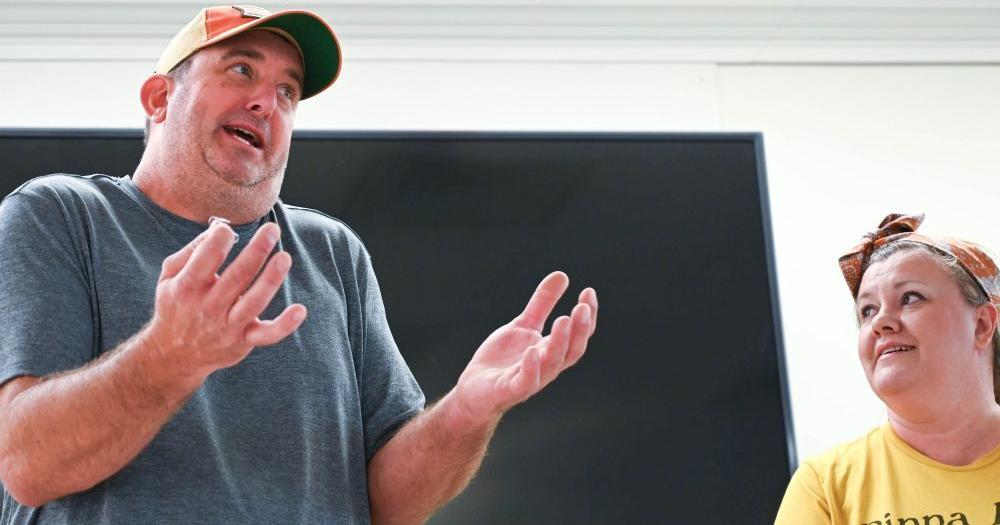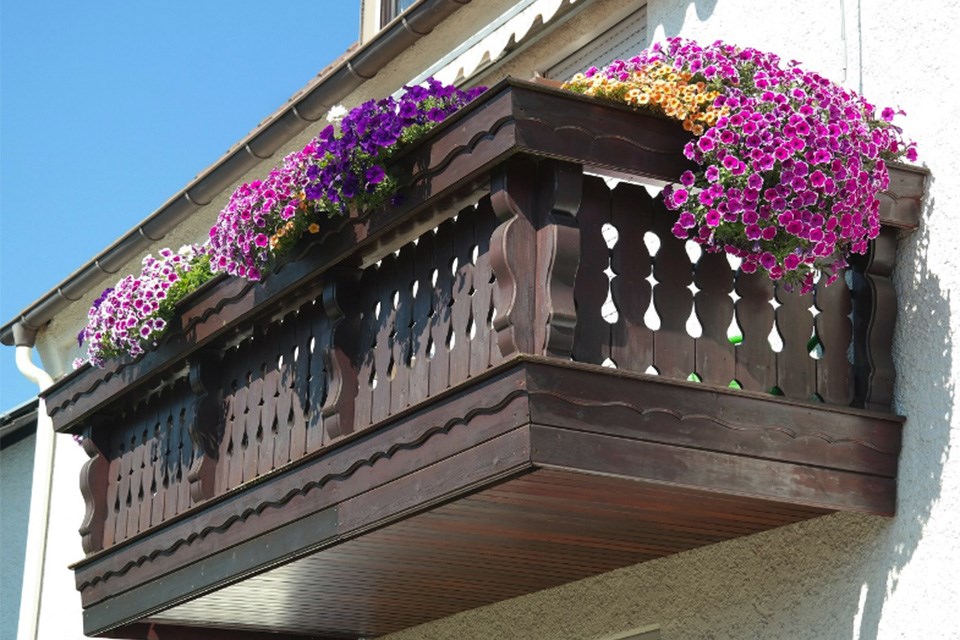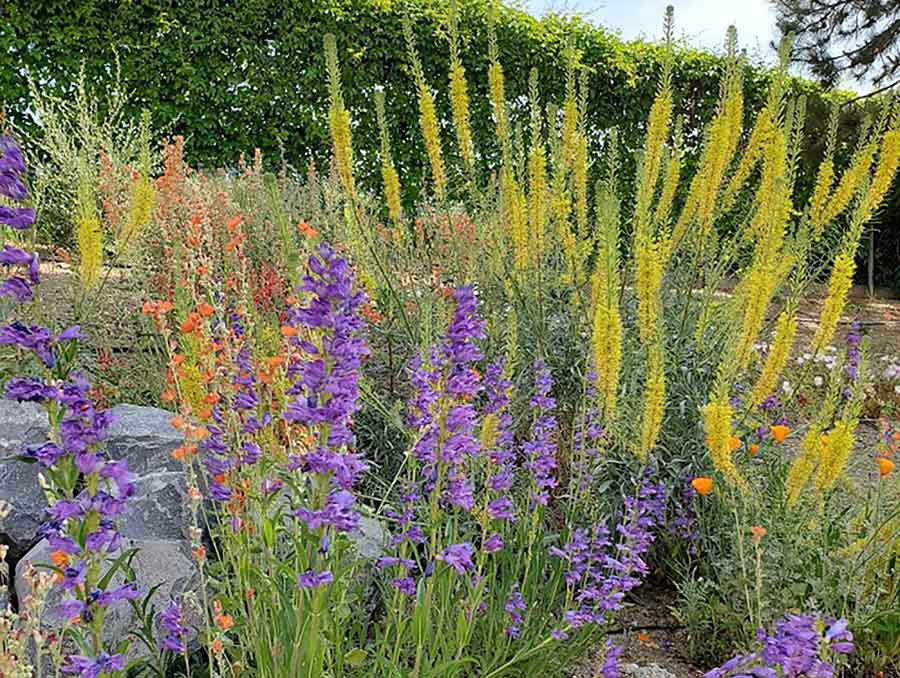Members of the USS Edwards gather to commemorate their time in Vietnam
On Monday, members of the USS Edwards tour the Literary Gardens portion of the Durango Botanical Gardens. (Tyler Brown/Durango Herald)
The former service members visited the Durango Botanical Gardens on Monday to celebrate the 50th anniversary of their service on the USS Edwards in Vietnam.
Veterans and their partners strolled through the newly added Literary Gardens to enjoy a day in the sun.
All four members were Navy fire control technicians on the USS Edwards. The group has visited different locations across the country to celebrate over the past 22 years.
“Basically a couple guys on the East Coast thought it would be cool if we all got together, so they started sending emails announcing when and where we were getting together,” the Navy veteran said. Don Sims.
The group chose Durango because it was a central location to where they were all from. The veterans came from states across the country, including California, West Virginia, Washington and Oklahoma.
Sims said there were 260 members in the group, many of whom wanted to go to San Diego. But the group had been to San Diego before, and others wanted to explore somewhere new, making Durango a timely destination.
Although others were reluctant to visit Durango, the group was happy with their decision. The group was blown away by all the activities Durango had to offer on such a small scale.
They spent an hour touring the gardens with the guides from the Botanical Garden where they asked questions and learned about the different flowers and plants. The Sims liked the layout of the garden and how well organized it was, while another veteran, Ben Smith, obsessed over a used container in the garden.
“I like the container because now I know what I can buy at home to play with the tomatoes,” he said.
After enjoying all the gardens had to offer, veterans sat around picnic tables to talk about their history while sharing a few laughs.
Navy veteran Ben Smith examines the fuel garden container during his tour of the Durango Botanical Gardens on Monday. (Tyler Brown/Durango Herald)
When asked if he could share any interesting stories from his service, Navy veteran Worthy Paul jokingly replied, “None that we can tell.”
Paul found it interesting that most people don’t know the Navy was involved in the Vietnam War. He shared stories of long nights involved in fights on the water.
“We were shooting at them and they (shooting at us) all night long,” he said. “We had this thing called an observation pilot and he was flying low to give us the coordinates to shoot, and our job was to follow his coordinates and shoot at that location.”
He said this type of combat happened every night in the navy, which made him grateful for peacetime.
“No matter how hot it is today, it’s still not that hot,” Paul said. “Where ammunition is stored below decks, there’s purposely no ventilation. So when you cross that deck to load ammo, you start sweating just standing there.
Smith shared a story of falling asleep behind a gun rack while shooting.
“We worked so many hours, I fell asleep behind a gun and they fired I don’t know how many shots, and I didn’t wake up. That’s probably why I use hearing aids now,” he said.
Guides discuss the different types of vegetation on the trail to the Durango Botanical Gardens. (Tyler Brown/Durango Herald)
Barbara Johnson, director of marketing for the Durango Botanical Gardens, said welcoming veterans was special.
“The tours are so important because they really introduce people to the gardens, what we do, that we’re here for the education,” she said.
 Did you know that there is a state ground, just like the state flower (the poppy) and the state animal (the bear)? Yes, the soil in the state of California is called “San Joaquin” soil and was officially designated as such in 1997. The Central Valley has over one million acres of “San Joaquin” soil. […]]]>
Did you know that there is a state ground, just like the state flower (the poppy) and the state animal (the bear)? Yes, the soil in the state of California is called “San Joaquin” soil and was officially designated as such in 1997. The Central Valley has over one million acres of “San Joaquin” soil. […]]]> are easy to use and are more 90% correct.
are easy to use and are more 90% correct. A stop on the Master Gardening Central Bog Bridge can transport the viewer to Giverny, France. Looking down from the top of the bridge and over the ponds, Monet’s famous water lily paintings seem to come to life. The colorful flower gems float like water nymph crowns, but they’re actually suspended and held upright by […]]]>
A stop on the Master Gardening Central Bog Bridge can transport the viewer to Giverny, France. Looking down from the top of the bridge and over the ponds, Monet’s famous water lily paintings seem to come to life. The colorful flower gems float like water nymph crowns, but they’re actually suspended and held upright by […]]]> While returning from a trip to Dallas last week, I noticed a huge plume of smoke as I arrived in Duncanville. I thought it was a fire west of Alvarado. I got an alert phone call from the town of Alvarado, but it didn’t come. It was after I got home that I saw there […]]]>
While returning from a trip to Dallas last week, I noticed a huge plume of smoke as I arrived in Duncanville. I thought it was a fire west of Alvarado. I got an alert phone call from the town of Alvarado, but it didn’t come. It was after I got home that I saw there […]]]> Although not the best time to start a garden, summer is a good time to start planning a fall and spring garden. It was among the many treats Shane and Liz Caraway of Pippa Hill Farms in Oglesby shared during a free gardening class on Saturday at the Temple Public Library. Jenniffer Hentzen, head of […]]]>
Although not the best time to start a garden, summer is a good time to start planning a fall and spring garden. It was among the many treats Shane and Liz Caraway of Pippa Hill Farms in Oglesby shared during a free gardening class on Saturday at the Temple Public Library. Jenniffer Hentzen, head of […]]]> gardening specialist in Vancouver.”/> Allen Wilson is a gardening specialist in Vancouver. Email Allen Wilson at [email protected]. Photo We planted two maple trees near our house 15 years ago that grew to over 50 feet tall. We are worried that they will break and damage our house during a storm. A friend with a chainsaw […]]]>
gardening specialist in Vancouver.”/> Allen Wilson is a gardening specialist in Vancouver. Email Allen Wilson at [email protected]. Photo We planted two maple trees near our house 15 years ago that grew to over 50 feet tall. We are worried that they will break and damage our house during a storm. A friend with a chainsaw […]]]> Yoga at Nordstrom Court. Photo courtesy of The Gardens Mall The Gardens Mall will host the return of Namaste at The Gardens, a wellness-focused fitness, fashion and entertainment campaign this summer July 9-23 at various locations, featuring free fitness and yoga classes, healthy food demonstrations, chakra-focused experiences, juice bars, and more. In the mall’s Grand […]]]>
Yoga at Nordstrom Court. Photo courtesy of The Gardens Mall The Gardens Mall will host the return of Namaste at The Gardens, a wellness-focused fitness, fashion and entertainment campaign this summer July 9-23 at various locations, featuring free fitness and yoga classes, healthy food demonstrations, chakra-focused experiences, juice bars, and more. In the mall’s Grand […]]]>
 The Cultivating School Gardens conference will be held online on July 20. The conference is designed to teach participants tools, techniques and new ideas for using gardening and natural learning environments in classrooms and gardens. The Texas A&M AgriLife Extension Service event will take place from 8 a.m. to 4:30 p.m. Cost is $30 and […]]]>
The Cultivating School Gardens conference will be held online on July 20. The conference is designed to teach participants tools, techniques and new ideas for using gardening and natural learning environments in classrooms and gardens. The Texas A&M AgriLife Extension Service event will take place from 8 a.m. to 4:30 p.m. Cost is $30 and […]]]> Going from a large garden to the space available in a smaller house or apartment can be a difficult adjustment. In order to make this transition as easy as possible, it is important to consider the different options available and find the one that suits your desired garden. At a certain point in life, maintaining […]]]>
Going from a large garden to the space available in a smaller house or apartment can be a difficult adjustment. In order to make this transition as easy as possible, it is important to consider the different options available and find the one that suits your desired garden. At a certain point in life, maintaining […]]]> For those looking to hone their landscaping skills or who might be interested in becoming a volunteer master gardener, now is the time to enroll in the Home Horticulture Certificate Program., offered online, August 4 through September 29, by the University of Nevada, Reno Extension. Various topics will be covered, such as soils and plant […]]]>
For those looking to hone their landscaping skills or who might be interested in becoming a volunteer master gardener, now is the time to enroll in the Home Horticulture Certificate Program., offered online, August 4 through September 29, by the University of Nevada, Reno Extension. Various topics will be covered, such as soils and plant […]]]>